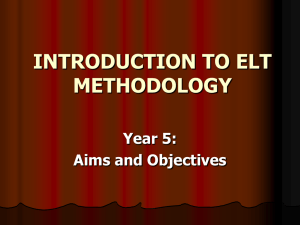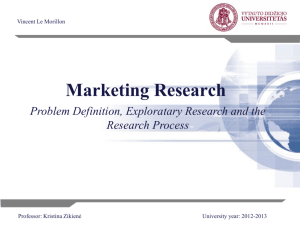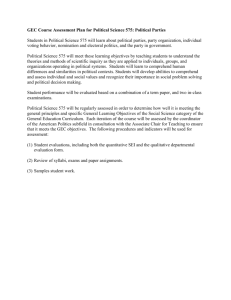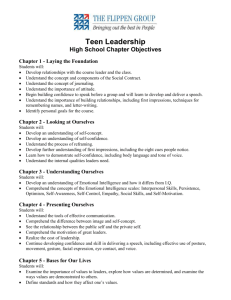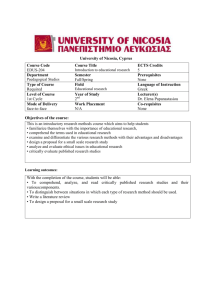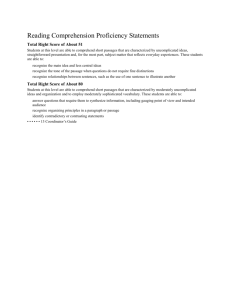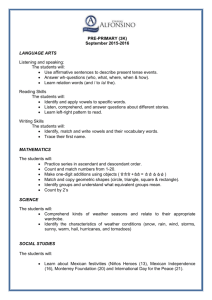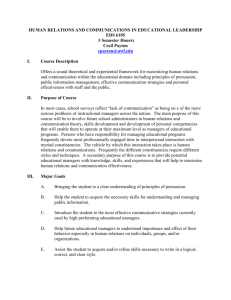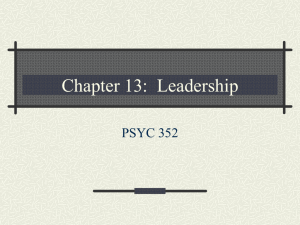Change and Development - SUNY Maritime College
advertisement
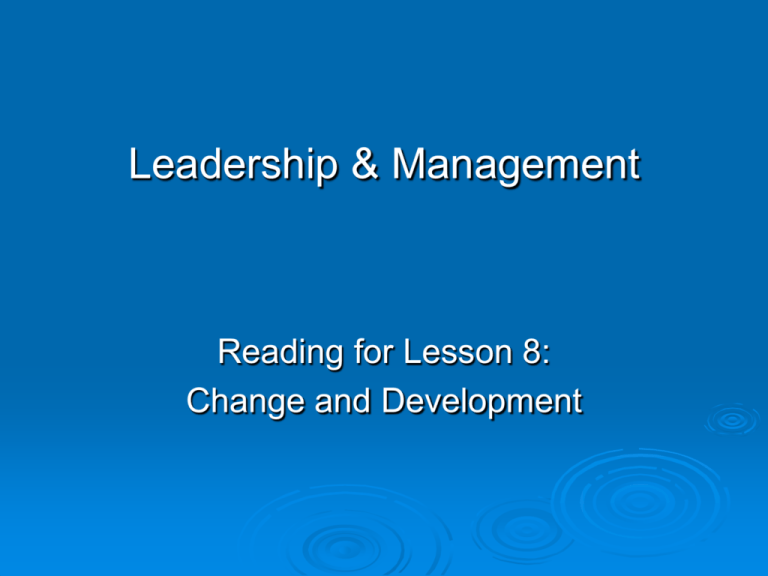
Leadership & Management Reading for Lesson 8: Change and Development Lesson 8 Reading Objectives 1. The student will comprehend the concept of organizational change and explain the forces for change. 2. The student will comprehend the sequence of four change activities that must be performed in order for change to be successful. 3. The student will comprehend techniques managers can use to facilitate the initiation of change in organizations including idea champions and new-venture teams. Lesson 8 Reading Objectives 4. The student will comprehend sources of resistance to change. 5. The student will comprehend force field analysis and other implementation tactics that can be used to overcome resistance to change. 6. The student will comprehend the differences between transactional, charismatic, and transformational leaders. 7. The student will comprehend which leadership style is best suited to lead organizational change. Lesson 8 Discussion Objectives 1. The student will comprehend techniques managers can use to facilitate the initiation of change in organizations including idea champions and new-venture teams. 2. The student will comprehend sources of resistance to change. 3. The student will comprehend which leadership style is best suited to lead organizational change. Concept of Organizational Change Defined as adoption of a new idea or behavior by an organization. Organizations need to continuously adapt to new situations if they are to survive and prosper By observing external trends, patterns and needs, managers use planned changed to help organization adapt to external problems and opportunities. Forces for Change Forces may exist in the external environment or within the organization. Environmental forces include: Customers Competitors Technology Economic International arena Forces for Change Internal forces for change arise from internal activities and decisions by: Management Employees Labor unions Production inefficiencies Change Activities Sequence Internal and external forces for change exist Organization managers monitor these forces and become aware of a need to change Perceived need triggers initiation of change Change is then implemented Initiating Change Develop ideas that solve perceived and communicated needs Responses may include: Search for a change to adopt • Process of learning about current developments inside or outside the organization to meet perceived need for change • Search typically uncovers existing knowledge that can be applied or adopted within organization Create a change to adopt Initiating Change (Cont.) Creativity is defined as the generation of novel ideas to meet perceived problems. Creative individuals develop ideas that can be adopted by the organization and are often known for: Originality Curiosity Open-mindedness Focused approach to problem solving Persistence Relaxed and playful attitude Receptiveness to new ideas. Initiating Change (Cont.) Creative organizational conditions include: Open channels of communication Assignment of non-specialists to problems Decentralization Freedom to choose problems Resources allocated to creative personnel without immediate payoff. Idea Champions and New-Venture Teams Idea champion. A person who sees the need for, and champions, productive change within the organization. New ideas must be carried forward for acceptance and implementation. Four roles in organizational change: Inventor Champion Sponsor Critic Idea Champions and New-Venture Teams New-Venture Team is a unit separate from the rest of the organization - develops and initiates innovations. Team typically small, loosely structured and organic Free of organizational rules, procedures and bureaucracy New-Venture Fund provides resources from which individuals and groups draw to develop new ideas, products or businesses. Resistance to Change Employees resist change due to: Self-interest—believe will lose something of value Lack of understanding and trust—do not understand intended purpose or distrust management Uncertainty—lack information; fear of unknown Different assessments and goals—employees may assess proposed change differently Strategies for Overcoming Resistance Two approaches: Analysis of resistance through the Force Field technique Use of selective implementation tactics to overcome resistance Strategies for Overcoming Resistance (Cont.) Force Field Analysis: Change is a result of competition between driving and restraining forces • Some forces drive it while others resist Selectively removing the restraining forces enables driving force to implement the innovation Strategies for Overcoming Resistance (Cont.) Implementation tactics: Communication and education • Used when solid information is needed by those resisting change, i.e., new technology or idea Participation • Involves potential resisters in designing change • Time consuming but pays off in user commitment • Helps managers determine potential problems and differences in perceptions among employees Strategies for Overcoming Resistance (Cont.) Implementation tactics: Negotiation • Formal bargaining to win acceptance and approval of change Coercion • Formal power is applied to force employees to change. Resisters told to accept or lose job Top management support • Visible support symbolizes importance of the change • Without this support change will probably not happen Change – An Approach Define the need Form a coalition of Managers Create the vision Communicate need and vision to subordinates Empower subordinates - Remove barriers - Change systems - Encourage risk-taking Demonstrate visible evidence of change Consolidate improvements Demonstrate relationship btwn new behavior & success Leadership Differences Three types of leadership—transactional, charismatic and transformational Transactional leaders: Clarify the role and task requirements of subordinates Initiate structure Provide appropriate rewards Try to meet the social needs of subordinates Leadership Differences (Cont.) Transactional leaders: Excel at management functions Are hardworking Are tolerant Are fair-minded Stress plans, schedules and budgets Leadership Differences (Cont.) Charismatic Leaders: Inspire/motivate people to do more, despite obstacles and personal sacrifice State a vision of an imagined future with which employees identify Shape a corporate value system for which everyone stands Trust subordinates and earn their complete trust in return Charismatic Leaders Mother Teresa & Martin Luther King - inspire positive outcomes for entire group - use enthusiasm & vision to motivate - group more important than personal need Adolf Hitler & Charles Manson - motivated by self-serving purposes - use fear & intimidation to motivate - personal need more important than group Leadership Differences Transformational Leaders: Bring about innovation and create significant change in followers and organization Lead changes in the organization's mission, structure, and human resource management Focus on intangible qualities • Vision, shared values, ideas to build relationships Provide common ground to enlist followers in changes. Which Leadership Style? Which suits YOU best? Which is most effective for YOU? Which most closely aligns with your strengths? Which most closely aligns with your beliefs? Is it situational? Is a combination best? Self-Assessment Realism vs. Idealism Introvert vs. Extrovert Skepticism (has its unique value) Stoicism (Epictetus; VADM James B. Stockdale) MOH: identifying urgent need & taking action No singular approach is appropriate ALL THE TIME!!! Combination is best for most people Application is highly situational… Self-Assessment (Cont.) What matters to you? What is best for a given situation? Who decides? Once you determine the answers to these foundational questions – all future can be addressed efficiently and effectively. In effect, the questions have already been answered… If these questions remain unanswered, you will struggle with the simplest of issues and will not be able to make decisions. You will remain on the “horns of a dilemma”… Situational…it depends! However… This is a foundation We are young…with much to learn This foundation is a living document that will mature with experience Your foundation should apply to the majority of situations you will encounter but…it depends! Self-Assessment (Cont.) Take the “test” on page 159… www.keirsey.com Myers-Briggs Type Indicator Strengths Finder 2.0 Strength Development Inventory Counseling and Psychological Services (CAPS) Don’t Worry…Be Happy! Things over which YOU have control Things over which you DO NOT have control Observe, evaluate, assess…anticipate! Generate solutions within your sphere of influence…expand your sphere! Make adjustments to meet the situation… Pick Your Battles! Be very selective What is the risk? What are the consequences? To Whom? Is it for the common good? Will this truly matter? Is it a matter of personal principle? What will you give up? Questions? ???
